The year ahead will be critical for policy to tackle aviation’s contribution to climate change. Following the outcomes of IATA’s annual meeting and COP26 in late 2021, global regulatory co-ordination of international aviation emissions is now firmly in the hands of ICAO. A review of CORSIA by its CAEP environment committee in February and a high-level meeting of ICAO member states in July on a long-term aspirational goal will be followed by the 41st Assembly in late September to formalise conclusions. Chris Lyle describes some key features in the process, notably the heavy reliance in the short- and mid-term on carbon offsetting and the need to turn sustainable aviation fuels into the primary mitigation tool. He looks at the policy challenges and constraints on ICAO alongside the consequential need for complementary action, at least by more ambitious governments.
Trade body IATA has consistently been a driver of ICAO policy and standards, not least on environmental measures. At the Association’s annual general meeting last October a resolution was adopted committing the airline industry as a whole to achieving a goal of net zero carbon emissions by 2050 and aimed at influencing ICAO’s long-term policy on climate change.
On the regulatory front, while the UNFCCC delegated the responsibility of emissions mitigation for international aviation through ICAO in the 1997 Kyoto Protocol, the issue has in the past few years moved into the mainstream. At COP26 in Glasgow, a day was devoted to transport during which the UK government brought together countries under the banner of the International Aviation Climate Ambition Coalition (IACAC) to present a declaration calling for “ambitious actions to reduce aviation CO2 emissions at a rate consistent with efforts to limit the global average temperature increase to 1.5⁰C” and “support the adoption by ICAO of an ambitious long-term aspirational goal consistent with the above-referenced temperature limit, and in view of the industry’s commitments towards net zero CO2 emissions by 2050”.
In addition to the UK, the declaration has 24 further signatories so far – more are being encouraged to join – including 13 European countries and others such as Canada, Japan, New Zealand, Republic of Korea, Turkey and the US, plus some from the developing world, but excluding major players such as Brazil, China, India, Russia and South Africa.
While the IATA text was deemed to represent consensus of all airlines present at the AGM, Chinese airlines, whose government has a generic target of net zero by 2060, expressed reservations – these were glossed over in the context of an industry agreement but may well raise difficulties at the intergovernmental level.
The IATA resolution was backed up by its Fly Net Zero scenario, with intermediate targets leading by 2050 to mitigation contributions of 65% from sustainable aviation fuels (SAF), 13% from new propulsion technology such as hydrogen, 3% from operations and infrastructure, and 19% from carbon offsetting and carbon capture (which could also be used to create more SAF). The IACAC declaration had no intermediate targets and lacked detail or backup.
Both IATA and IACAC strongly endorsed ICAO as the appropriate forum in which to address emissions from international aviation and, for the short- and mid-term, both were strongly supportive of, and heavily dependent on, carbon offsetting (the contribution anticipated by IATA being 93% in 2030 for example) and, in particular, ICAO’s Carbon Offsetting and Reduction Scheme for International Aviation (CORSIA).
The IACAC declaration opened the door to actions beyond the ICAO framework through the clause “Working together, both through ICAO and other complementary co-operative initiatives [author’s italics] towards net zero CO2 emissions by 2050”. In this context, concern by IATA regarding a “patchwork of measures” is overhyped. Airlines already deal with a plethora of differing charges and duties in the countries they serve, and the countries themselves, individually or in regional co-operation will ensure that measures they take do not unduly affect competition and become detrimental to their economies.
Drivers of action
In August 2021, the first part of the IPCC’s sixth Assessment Report (AR6), the physical science basis stated that evidence of the human contribution to climate change was now “unequivocal” and stressed the need to limit temperature increases to 1.5°C above pre-industrial levels. In February this year the second part of AR6 will be the latest assessment of the impacts of climate change and in March the third will report on future socio-economic pathways and how they would influence the climate. A synthesis report will be published in September.
These reports will undoubtedly keep concern regarding climate change on the front burner worldwide. As regards the aviation industry, a study published last November by an eminent group of scientists suggests emissions produced must be reduced each year if they are not to increase warming further, otherwise the sector could consume up to one-sixth of the remaining budget to limit warming to 1.5°C by 2050.
The Kyoto Protocol has now effectively lapsed and international aviation is de facto encompassed by the Paris Agreement in the same way as any other sector. While international aviation continues (with international shipping) to be treated separately and specifically, there has been increasing acknowledgement, now confirmed by a legal analysis, that it is to be included in the UNFCCC’s Nationally Determined Contributions (NDCs) under the Paris Agreement.
The UNFCCC currently has no explicit guidance on the allocation of international aviation emissions amongst Parties, but a number of countries including the UK and, under their collective NDC, all EU Member States will now include the first outbound leg of any international flight by any carrier in their NDCs.
The United States, which published its updated Aviation Climate Action Plan in November, and the EU have taken a lead in integrating aviation into a comprehensive emissions mitigation package. Both strongly endorse ICAO action and CORSIA. The European Commission’s ReFuelEU Aviation proposal would impose a blending mandate on fuel suppliers to include SAF in aviation fuel supplied at EU airports. The obligation would commence from 2025 at 2% SAF, gradually increasing to 63% (incorporating 28% synthetic kerosene) by 2050. Some EU countries have already brought in a mandate and the UK is due to set out proposals this year for its own mandate.
When the EU decided to include intercontinental flights in its Emissions Trading System from 2012, negative reaction from other countries led to suspension of this application, but that covered flights both to and from EU territory. In the context of NDCs, a proposal by the European Commission to apply the ETS to maritime emissions as part of its ‘Fit for 55’ package, including 50% of emissions from voyages which start or end outside of EU territory, seems to have been more acceptable.
The contribution of CORSIA
CORSIA is a complex form of carbon offsetting and is not aimed at the reduction of emissions but rather sets out to achieve a goal of carbon neutral growth, now with a 2019 baseline – at present CORSIA is estimated to cover only 25% of international aviation emissions through its lifetime to 2035. In addition, CORSIA is fragile and, being based on ICAO Assembly Resolutions and implemented through ICAO Standards and Recommended Practices, it will at no point be binding under international law. Countries such as those major players mentioned above in the context of exclusions from the IACAC Declaration are by no means committed to CORSIA.
The ICAO scheme cannot currently therefore be considered as a significant emissions mitigation measure. However, CORSIA is a comprehensively developed mechanism containing crucial elements such as standards on Monitoring, Reporting and Verification. ICAO has also established ‘CORSIA Sustainability Criteria for CORSIA Eligible Fuels’ which could become an important feature in a more general context. Thus there appears to be some consensus that rather than trying to ‘reinvent the wheel’, CORSIA provisions should be reinforced.
One option floated would be to have it apply at some point to all emissions rather than those above 2019 levels However, this would be in direct contradiction of the ICAO action in 2020 actually to change the baseline to compensate for the impact of Covid-19. Another option rumoured to be under consideration by ICAO’s environmental protection committee CAEP, but reportedly facing strong opposition by some fossil fuel providers, would be in-sector offsetting for funding or purchase of certified SAF products.
Nevertheless, the bottom line is that CORSIA is likely to remain substantially inadequate. ICAO’s current basket of emissions mitigation measures for international aviation – technology, operations, CORSIA and SAF – will contribute pro rata much less than any of the first NDCs to which 192 UNFCCC Parties have committed. Climate Action Tracker has concluded these measures, and notably CORSIA, are “critically insufficient” (the worst level) and compatible with a 4°C+ world.
The scientific consensus in the context of the Paris goals is that aviation emissions need to be reduced at least half from 2019 levels by 2030, en route to net zero carbon by 2050. ICAO has been “exploring the feasibility” of a global long-term aspirational goal (LTAG) for mitigation of international aviation emissions for the past eleven years and is finally expected to adopt one at its Assembly Session this year.
Global SAF policy
Electric and hydrogen powered aircraft are now in prototype or on the drawing board, with the potential to reduce air transport emissions substantially in the longer term. But given they will not have a major global market presence until close to mid-century, particularly at the long haul, there is a critical need for early address of other means of reducing aviation’s emissions. As indicated above, the primary emissions reduction contributor in mid-century is expected to be sustainable aviation fuels, notably waste-based fuels and synthetic e-fuels. However, SAF production and take-up are currently negligible, with very high costs (three or more times than fossil jet fuels) and there is an urgent need for stimulative action.
During a side event at COP26, the World Economic Forum launched a ‘Sustainable Aviation Fuel Policy Toolkit’. This guide should help smaller States in particular to develop SAF. However, a number of countries, including for example small islands with high tourism and hence air traffic, are unlikely to have the capacity to produce SAF in adequate quantities – they may well require special treatment in global policy. There will also be a need to address aspects of specifying and verifying SAF consumption given blending into regular kerosene at airport fuel farms or purchase based on ‘book and claim’ (in which the SAF is not physically transported and entered into the specific aircraft of the entity covering the fuel premium but goes into the fuel system at an airport close to the SAF production facility); in such cases the contribution cannot usually be set against specific flights.
A fundamental need going forward is for clarity of definitions used in the aviation sector of ‘carbon neutral’, ‘zero carbon’, ‘zero emissions’ and ‘carbon net zero’. The IATA, IACAC and EU interpretations of carbon net zero for aviation include out-of-sector carbon offsetting or removals. Proponents of hydrogen and electric power claim that they will be zero carbon – however, this relates only to the flights themselves and excludes the manufacturing and distribution process, a factor which needs to be incorporated.
The sector also needs to address the implications of non-CO2 emissions and contrails, with recent research indicating that they contribute substantially to radiative forcing, although they are correlated as of decreasing in importance with CO2 reductions.
On the global policy front, ICAO remains considerably constrained in having to relate the UNFCCC’s principle of ‘Common But Differentiated Responsibilities and Respective Capabilities’ with the ‘equal application’ provisions of the Chicago Convention. Developing a universal commonality for 193 States takes considerable time and effort and has resulted in a lowest common denominator of CORSIA. Furthermore, the UN agency has no regulatory authority over any individual Member.
With ICAO constrained by the Chicago Convention and lacking regulatory authority, it is clear that other complementary initiatives to multilateral sectoral arrangements on aviation emissions reduction, such as CORSIA or the EU ETS, will be critical. Groups of countries or even individual countries should be free to add their own more ambitious action as promoted by the Paris Agreement. Coalitions of the more ambitious may well be more impactful than global application of lowest common denominator.
States should not be constrained, as they have been in the past, from applying such instruments as fossil fuel levies and low-carbon fuel blending mandates. Direct carbon levies are a potential policy vehicle. Tax exemptions for fossil fuels, which discriminate in favour of air transport and against SAF, electric and hydrogen powered aircraft alike, should be removed but with ring-fencing of revenues for alternative fuel and power source development. Such measures fall within the remit of individual governments, beyond ICAO competency.
Potential ICAO Assembly outcomes
ICAO has planned a careful and comprehensive build up to its 41st Assembly Session. In addition to the technical advice from CAEP in February, there will be five regional Global Aviation Dialogues (GLADs) on a LTAG in March/April and a two-day stocktaking immediately prior to the high-level meeting (HLM) to be held, albeit “in principle”, from 20-22 July. A series of GLADS has been held, initially in 2015, aimed at familiarising participants and receiving feedback on proposals for global market-based measures, and in 2021 on a LTAG.
This year’s series (virtual) is aimed at providing more information on a LTAG and, in particular, results of a CAEP analysis on LTAG scenarios with cost impacts. The objective of the HLM, for which arrangements have yet to be finalised, will look at scenarios, options and means of implementation of a LTAG with a view to making recommendations to the governing ICAO Council for consideration in preparation for the Assembly.
The coming Assembly Resolution(s) might include, first and foremost, a commitment to a clearly defined carbon net zero target for international aviation by 2050. If it is to be credible, that long-term goal will require intermediate targets including one for the reduction of international aviation emissions by at least half from 2019 levels by 2030. More frequent intermediate targets could also be set for review every three years at ICAO Assembly Sessions. The policy should evidently include strengthening of the ICAO basket of emissions mitigation measures, notably CORSIA. At the same time, it is likely to encourage evolution of new technologies such as electric and hydrogen powered aircraft.
Even adoption by ICAO of a 2050 carbon net zero target for international aviation is by no means a given. While some 135 countries have now set or are considering a target of reducing their overall emissions to net zero, only about half of these have specified a target year. Of these, major nations such as Brazil, China, Nigeria, Russia, Saudi Arabia and Ukraine are targeting 2060, and India 2070. The number of countries with commitments to net zero 2050 specifically for aviation is far fewer, even if it includes EU Member States, the UK and the US.
As regards SAF, ICAO can offer general guidance if not metrics specific to individual States. A Resolution might provide a clear definition of what is an acceptable SAF (against a criterion such as a 70% or greater reduction in CO2 versus kerosene on a full life cycle basis). It might also include some indicative global figures for quantified proportions of such SAF. And it could offer a roadmap regarding the early development and application of SAF through:
- progressive SAF mandates;
- tax credits for SAF suppliers (both producers and airports);
- levies on aviation fossil fuels, ring-fenced to SAF production and purchase;
- SAF investment guarantees and green financing; and
- prioritisation of applicable alternative fuel production to the aviation sector.
A valuable, if perhaps optimistic, element in a Resolution would be recognition of the inclusion of international aviation into NDCs through adopting the EU and UK lead in acceptance of national authority/control over the emissions from the first outbound leg of all international flights – with no discrimination in favour of airlines with principal place of business or an AOC in the country concerned.
The concept of holding a high-level meeting in preparation for the Assembly is a constructive innovation since it provides full time devotion to a single subject and should deliver the foundation for action by the Assembly. But while substantial progress towards reaching a global agreement will undoubtedly be made, some countries may reserve their final position until they have reviewed the outcome and implications in depth. There is no doubt that relevant Assembly Resolutions will be adopted but States who feel that the policy is inappropriate or too strong may well, as in the past, file reservations against specific aspects, while other countries will be seeking to assure the flexibility for them to take their own additional action.
ICAO should not restrain but rather encourage greater ambition, on the understanding that it should be complementary rather than undermining or conflicting with the ICAO framework. ICAO measures can only be limited and action by coalitions of the more ambitious will be a necessary means of supplementing the ICAO guidance, or perhaps even the primary mitigation measures – with demand management already appearing above the horizon.
Photo: Opening plenary session of ICAO’s 40th Assembly in 2019
Views expressed in Commentary op-ed articles do not necessarily represent those of GreenAir.


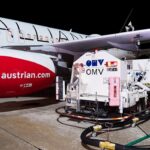
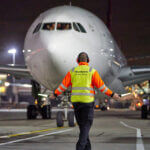
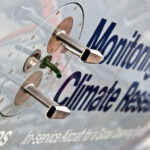



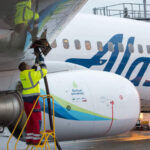
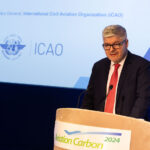



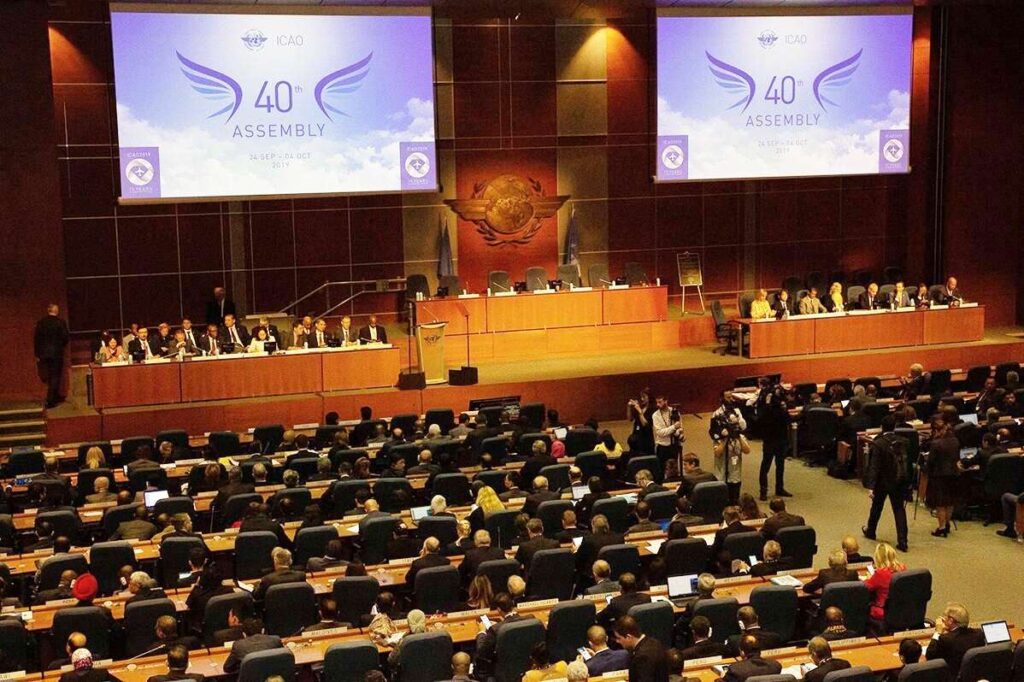


More News & Features
Commentary: China’s fair and equitable solution to civil aviation’s climate challenge
COMMENTARY: Airline industry faces carbon credit shortage in net-zero push
COMMENTARY: Capping aviation emissions – a pressing necessity with a potential solution
COMMENTARY: Tourism and aviation emissions mitigation policy – disparate and inadequate
COMMENTARY: With mounting challenges over its climate impact, is aviation’s social licence at risk?
COMMENTARY: Deconstructing the roadmaps – what to expect from aviation emissions reduction plans